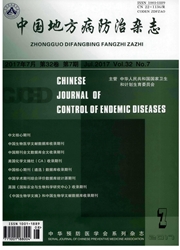

 中文摘要:
中文摘要:
目的探讨不同碘摄入水平地区学龄儿童智商水平。方法采用整群抽样,以饮用水碘水平进行分组,用中国联合型瑞文测验(CRT—C2)方法测验8~10岁儿童智商(IQ)。结果饮用水碘中位数为20.29、143.23和827.59μg/L的3组地区儿童的IQ值分别为100.76、103.53和101.62,轻度智力低下发生率依次为2.7%、3.5%和3.2%,其各组之间的差异均无统计学意义(P〉0.05)。男、女儿童IQ值为103.91和100.78分,智力低下率为1.9%和4.8%,亦都无统计学差异(P〉0.05)。一至四年级儿童的IQ值分别为102.84、100.69、103.50和99.88分,智力低下率分别9.4%、4.4%、2.3%和0,差异也无统计学意义(P〉0.05)。结论生活在碘过量地区的儿童即使饮用水水碘〉800mg/L时,同时有碘盐覆盖,儿童智商发育也未见异常。
 英文摘要:
英文摘要:
Objective To study the levels of school - aged children's intelligence quotient(IQ) in different areas of iodine intake from drinking water. Methods The children of 8 to 10 years were sampled by cluster sampling. The samples of them were divided into three groups according to drinking water iodine concentration. IQ values were tested by Raven's scale in China( CRT - C2). Results The median of water iodine concentration from three areas was 20.29, 143.23 and 827.59 μg/L. The IQ points of three areas were 100.76, 103.53 and 101.62. No statistic significance of average difference of the groups compared with each other was found with ANOVA test. The rates of IQ ≤69 of different groups were 2.7%, 3.5% and 3.2%. No statistic significance of rate difference of them compared with each other was found with Chi - Square test. The proportions of children whose IQ≤69 were 1.9% and 4.8%, and IQ points of boys and girls were 103.91 and 100.78 respectively. No statistic significance of average difference or rate difference of male and female. The IQ points of pupils from one to five grades were 102.84, 100.69, 103.50 and 99.88, and their rates of IQ ≤69 were 9.4%, 4.4%, 2.3% and 0. Conclusions There was no abnormal of IQ in which water iodine concentration more than 800 μg/L with salt iodized supply. It indicated that for the children living in the iodine excess environment, their intelligence development was normal.
 同期刊论文项目
同期刊论文项目
 同项目期刊论文
同项目期刊论文
 期刊信息
期刊信息
